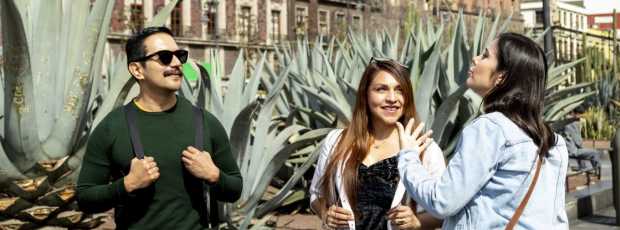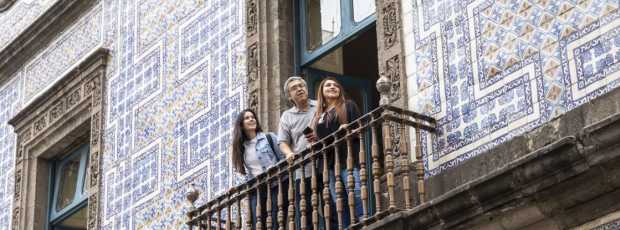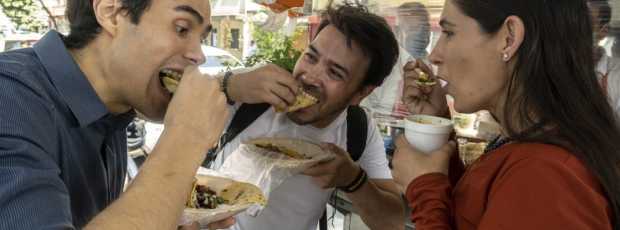Table Of Contents
- The Real Geography of Roma
- Morning Coffee Culture and Leafy Streets
- Art Galleries and Cultural Spaces That Define the Scene
- Plaza Río de Janeiro: The Neighborhood's Social Hub
- Mercado Roma and the Broader Food Scene
- Bars and Nightlife: From Neighborhood Hangouts to Destination Spots
- Shopping That Reflects Local Taste
- Roma Norte's Stunning Architecture and Historical Context
- Navigating Between Roma Norte and the Condesa Neighborhood
- Evening Culture and Rooftop Bar Scene
- Local Favorite Restaurants and Dining Experiences
- Planning Your Visit to Roma, Mexico City
- Hidden Gems and Local Discoveries
- Making Roma Norte Work for Different Travel Styles
- The Rhythm You Take With You
The first time I walked through Roma Norte, Mexico City, on a Tuesday morning, I understood why locals guard this neighborhood like a secret. It wasn't the Art Nouveau architecture or the sidewalk cafés that got me. It was the rhythm. People here move differently from in the Centro Histórico or even nearby Condesa. There's less rushing, more lingering. More conversations that spill from coffee shops onto sidewalks.
Roma Mexico City operates on its frequency, and once you tune in, everything else feels a bit frantic by comparison. This Colonia Roma neighborhood has become Mexico City's most talked-about district, drawing visitors from Latin American countries and beyond who want something more genuine than the typical tourist circuit.
The Real Geography of Roma
The Roma neighborhood splits cleanly along Avenida Cuauhtémoc into two distinct personalities: Roma Norte and Roma Sur. Think of it like this: Roma Norte is your friend who always knows the best new coffee roaster before it gets crowded. Roma Sur is your friend who takes you to family-run taquerias that have never needed to advertise.
Roma Norte gets most of the attention, and for good reason. This is where you'll find the boutique hotels, the carefully curated vintage stores, and the kind of breakfast spots that make you want to extend your Mexico City trip by a week. But Roma Sur holds its own quiet magic. It's more residential, more family-oriented, and significantly less expensive for everything from tacos to rent.
The entire Roma area is centrally located between the historic center and the more polished neighborhoods to the south. You can walk to the Centro Histórico in about an hour, or catch the metro at Insurgentes station and be anywhere in Mexico City within an hour.
Morning Coffee Culture and Leafy Streets
By 8 AM, Roma Norte comes alive in layers. First, the commuters heading to offices in Polanco or Santa Fe. Then the coffee crowd, settling into sidewalk tables with newspapers and laptops. Finally, the neighborhood residents are running errands, walking dogs, and picking up groceries from small shops along Colima Street and leafy streets like Orizaba Street.
Places like Café Nin serve amazing coffee in spaces that feel more like living rooms than cafés. The baristas know regulars by name and drink preference. Panadería Rosetta has become a Roma Norte, Mexico City institution, drawing both locals and visitors for their exceptional pastries and coffee service. It's these small touches that make Roma feel less like a place you're visiting and more like somewhere you could belong.
Breakfast culture in Roma Norte runs deep. French toast appears on menus everywhere, but each place has its own interpretation. Some add Mexican vanilla and cinnamon. Others serve it with seasonal fruit from nearby markets. The best versions come with servers who ask how you like your coffee, and wait for the answer.
Looking for a private city experience in Mexico City?
Explore the city with a local who plans a private day just for you; no groups, no scripts.
Art Galleries and Cultural Spaces That Define the Scene
Art galleries in Roma don't announce themselves with flashy signage or tourist-friendly hours. Many operate more like cultural spaces than commercial ventures. Casa Lamm combines gallery exhibitions with a bookstore and café, creating the kind of environment where you might spend an entire afternoon without realizing it. The cultural center has become essential to understanding Roma's intellectual atmosphere.
The Object Museum (Museo del Objeto) holds an impressive collection of design pieces and rotating exhibitions that focus on Mexican visual culture. Street art has also become increasingly prominent throughout the Roma neighborhood, with many buildings featuring murals that reflect both contemporary themes and references to the Mexican Revolution.
What makes the art scene in Roma Norte work is how it weaves into daily life. Galleries host book launches, film screenings, and panel discussions. They function as community spaces first, tourist attractions second. This means you're more likely to meet locals who can point you toward their current favorite exhibition or tip you off about upcoming openings.
Plaza Río de Janeiro: The Neighborhood's Social Hub
The fountain (a replica of the Fuente de Cibeles from Madrid) provides a focal point, but the real action happens on the benches and pathways surrounding it. This small plaza, within walking distance of most Roma Norte attractions, becomes especially lively during evening hours.
Rio de Janeiro plaza is where you come to people-watch without being obvious about it. Families with young children, groups of friends planning their evening, and couples sharing street food from nearby vendors. The plaza feels both communal and intimate, probably because it's sized for the neighborhood rather than designed for crowds. Plaza Luis Cabrera, another small plaza nearby, offers a quieter alternative for those seeking a more peaceful spot to sit and think.
The streets radiating from Plaza Río de Janeiro contain some of Roma Norte's best restaurants and bars, but they also hold the small details that make the area special: the corner pharmacy that's been family-owned for decades, the shoe repair shop that still does hand-stitching, the newsstand that stocks international magazines alongside local papers.
Mercado Roma and the Broader Food Scene
Street vendors position themselves strategically outside apartment buildings during morning and evening rush hours. They know their customers' preferences and adjust their offerings accordingly.
Mercado Roma gets attention as a gourmet food hall, and it earns that reputation. But it's worth understanding Mercado Roma as part of a larger food ecosystem. The market vendors source ingredients from the same suppliers used by neighborhood restaurants. You can buy the same quality chiles and fresh tortillas, then watch how professional cooks transform them at the food stalls.
Tuna tostadas have become something of a signature dish in Roma Norte, appearing on menus at both casual spots and more formal restaurants. The preparation varies, but the best versions balance the fish with avocado, pickled onions, and just enough lime to brighten everything without overwhelming the tuna's flavor. The unique blend of traditional Mexican ingredients with contemporary presentation techniques defines much of Roma's culinary identity.
What if your day in Mexico City was planned by someone who knows it — and you?
City Unscripted matches you with a local host who creates a private experience based on your interests, not a set route.
Bars and Nightlife: From Neighborhood Hangouts to Destination Spots
Bars in Roma Norte, Mexico City, generally fall into two categories: neighborhood hangouts and destination spots. Bar Las Brujas represents the destination category, a cocktail program that draws people from across Mexico City, housed in a building locals call the "witches house" for its gothic revival architecture. The bar can get busy on weekends and may charge a cover, but the atmosphere and drinks are worth it.
The neighborhood hangout category includes places like El Palenquito, where craft beer selection matters more than interior design. These bars stay open late without trying too hard to be a scene. Conversations flow easily. The music stays at a volume that allows talking. Dancing happens when it feels natural, not because there's a designated dance floor.
Live music in Roma Norte tends toward intimate venues rather than large clubs. A live band might play salsa music one night and jazz the next. Mama Rumba offers live music performances that draw both locals and visitors, while maintaining an authentic neighborhood feel. The programming reflects the neighborhood's cultural diversity rather than catering to tourist expectations.
The emphasis on quality over quantity means you'll find carefully curated menus rather than extensive but mediocre options. Some venues transform throughout the evening, starting as casual dinner spots and evolving into more energetic bars as the hours progress.
Shopping That Reflects Local Taste
Boutique shops in Roma Norte curate carefully rather than stocking extensively. Vintage stores focus on specific eras or styles. Independent bookstores organize sections according to the owner's literary preferences rather than commercial categories.
This approach to retail means shopping in Roma Norte feels more like browsing through someone's collection than navigating a commercial district. Store owners often know the provenance of individual pieces and can explain why they chose to stock particular items.
The concentration of boutique shops along streets like Orizaba and Colima creates natural walking routes. You can spend a morning moving between stores, stopping for coffee, checking out a gallery, then continuing to browse. The pace encourages lingering rather than efficient purchasing.
Roma Norte's Stunning Architecture and Historical Context
Stunning architecture in Roma Norte spans several decades and influences. Art nouveau styles from the early 20th century coexist with mid-century apartment buildings and contemporary renovations. Art deco elements appear throughout the neighborhood, particularly in buildings from the 1920s and 1930s. This layering creates visual interest without feeling chaotic.
Many apartment buildings retain original details like tile work, ironwork balconies, and carved stone facades. Property owners have generally chosen restoration over replacement, preserving the neighborhood's architectural character while updating interiors for contemporary use. Like much of Colonia Roma, La Romita reflects the neighborhood's layered architectural history
The building diversity reflects Roma Norte's social and economic evolution. Some blocks feature grand single-family homes converted to boutique hotels or cultural centers. Others contain modest apartment buildings where families have lived for generations. This mix prevents the neighborhood from feeling too polished or exclusive. Historians note that Roma fell into disrepair following the 1985 earthquake, but careful restoration efforts have brought much of the architectural heritage back to life.
Tip
We match you with the right host, not just any guide.Want to experience the real Mexico City with someone who lives there?
A fully private experience, planned and led by a local host who tailors the day to you
Navigating Between Roma Norte and the Condesa Neighborhood
The Condesa neighborhood sits just south of Roma Norte, and the boundary between them blurs along Avenida Álvaro Obregón. Many visitors try to choose between the two neighborhoods, but locals treat them as complementary rather than competitive.
Roma Norte offers more variety in terms of cultural activities, shopping, and food options. Condesa provides better access to parks and leans toward a more relaxed, residential atmosphere. If you're staying in one, you can easily walk to the other for dinner or drinks. Both areas maintain walking distance to major attractions and transport hubs.
The metro system connects both neighborhoods efficiently to the rest of Mexico City. From Insurgentes station, you can reach Mexico City International Airport in about an hour, or travel to other neighborhoods like Coyoacán or Centro Histórico without needing taxis or ride-sharing services.
Evening Culture and Rooftop Bar Scene
As afternoon shifts to evening, Roma Norte's energy changes rather than simply intensifies. Sidewalk cafés transition from coffee service to wine and cocktails. Restaurant outdoor seating fills with groups planning their night or finishing long dinners.
You can have a quiet drink at a wine bar, attend a cultural event at Casa Lamm, or dance until late at one of the bars along Coahuila Street. A rooftop bar experience might offer views over the Roma neighborhood's tree-lined streets and historic architecture. The options don't compete with each other – they serve different moods and occasions.
Many Roma Norte bars stay open late without becoming exclusively late-night destinations. This flexibility means you can start with dinner at 8 PM and gradually shift to drinks and socializing without changing venues or making specific plans. The relaxed atmosphere encourages an unhurried approach to evening entertainment that feels distinctly Mexican.
Local Favorite Restaurants and Dining Experiences
Certain places in Roma Norte have achieved local favorite status through consistency rather than novelty. These spots serve their regular customers well while remaining welcoming to newcomers.
La Valise operates as both a restaurant and a bar, adjusting its service and atmosphere according to the time of day. La Valise offers a tasting menu that changes seasonally, but individual dishes are available for those who prefer to order selectively. The Michelin Guide recognized La Valise's quality, but locals were already aware. The restaurant represents the kind of establishment that makes Roma Norte feel sophisticated without being pretentious.
Guava roll appears on several Roma Norte dessert menus, but the best restaurants prepare versions that balance the fruit's sweetness with complementary flavors like lime or chili. It's become something of a neighborhood signature, reflecting the area's ability to take traditional Mexican ingredients and present them in contemporary contexts.
The best restaurants in Roma Norte often operate with limited seating and focused menus. They prioritize doing fewer things exceptionally well rather than offering extensive options. This means reservations help, but many local favorite establishments accommodate walk-ins if you're flexible about timing.
Ready to plan your perfect day in Mexico City?
Start your experiencePlanning Your Visit to Roma, Mexico City
Most visitors underestimate how much time the Roma neighborhood deserves. A quick walk-through misses the neighborhood's essential quality: its invitation to slow down and pay attention to details.
A full day allows time for morning coffee, gallery browsing, lunch at a local favorite, afternoon shopping, and evening drinks. But Roma, Mexico City, also works well as a base for exploring other parts of the city. Many boutique hotels provide comfortable accommodation with central location benefits that make other neighborhoods easily accessible.
The area's walkability means you can cover significant ground on foot while maintaining a relaxed pace. Frequent cafés and bars offer places to rest and observe the neighborhood's rhythm. The city reveals its character gradually, rewarding visitors who resist the urge to rush through their itinerary.
Hidden Gems and Local Discoveries
What locals call hidden gems in Roma Norte are usually places that don't advertise heavily or court tourist attention.
These spots might include a quiet place for afternoon coffee that locals use as an informal office, or a rooftop bar that opens only on certain evenings but offers exceptional views and cocktails. Finding them requires asking questions and following up on casual recommendations rather than relying on guidebooks or review websites.
The best restaurants in Roma Norte often operate with limited seating and focus on their menus. They prioritize doing fewer things exceptionally well rather than offering extensive options. This approach means reservations help, but many places accommodate walk-ins if you're flexible about timing. Some establishments serve both tourists and locals alike, maintaining quality while remaining approachable to newcomers.
Making Roma Norte Work for Different Travel Styles
Whether you're planning romantic things to do in Mexico City or looking for cultural immersion, Roma Norte adapts to different approaches. Couples can find intimate restaurants, wine bars, and quiet places for conversation. Cultural enthusiasts have galleries, bookstores, and venues that host regular events.
Families discover that Roma Norte offers more variety and fewer crowds than some Mexico City neighborhoods. Children can run safely in Plaza Río de Janeiro while parents enjoy coffee or drinks at nearby establishments. Many restaurants welcome families during earlier evening hours.
Solo travelers often find Roma Norte particularly welcoming. The café culture supports lingering over coffee and books. Gallery openings and cultural events provide natural opportunities to meet people. The neighborhood's walkability means you can explore confidently without extensive planning.
The Rhythm You Take With You
After spending time in Roma Norte, other neighborhoods in Mexico City can feel rushed or impersonal by comparison. The area's particular blend of cultural sophistication and neighborhood intimacy sets expectations about how urban life can function.
This isn't necessarily better or worse than other approaches to city living, it's simply different. Roma Norte operates on the assumption that daily life should include beauty, good coffee, interesting conversations, and time to notice details. Once you've experienced this rhythm, it becomes a reference point for evaluating other places.
The neighborhood succeeds because it serves residents first while staying open to visitors who appreciate its particular qualities. This balance creates authenticity that can't be manufactured or replicated, it develops through years of small decisions made by people who live there every day.
Whether you spend a morning or a week in Roma Norte, you'll likely leave understanding why Mexico City locals consider it special. It’s no surprise that Roma Norte, Mexico City, has become a favorite for travelers looking to slow down and stay present. It's not just about the restaurants or galleries or bars, though those are all excellent. It's about how a neighborhood can maintain its character while remaining part of a larger, complex city. It's about rhythm, pace, and the small daily pleasures that make urban life worthwhile.
Ready to experience Roma Norte like a local? Our Mexico City experiences connect you with hosts who know the neighborhood's real rhythm – from morning coffee spots to evening bar recommendations, all tailored to your interests and pace.
What if your day in Mexico City was planned by someone who knows it — and you?
City Unscripted matches you with a local host who creates a private experience based on your interests, not a set route.
Want to experience the real Mexico City with someone who lives there?
A fully private experience, planned and led by a local host who tailors the day to you











